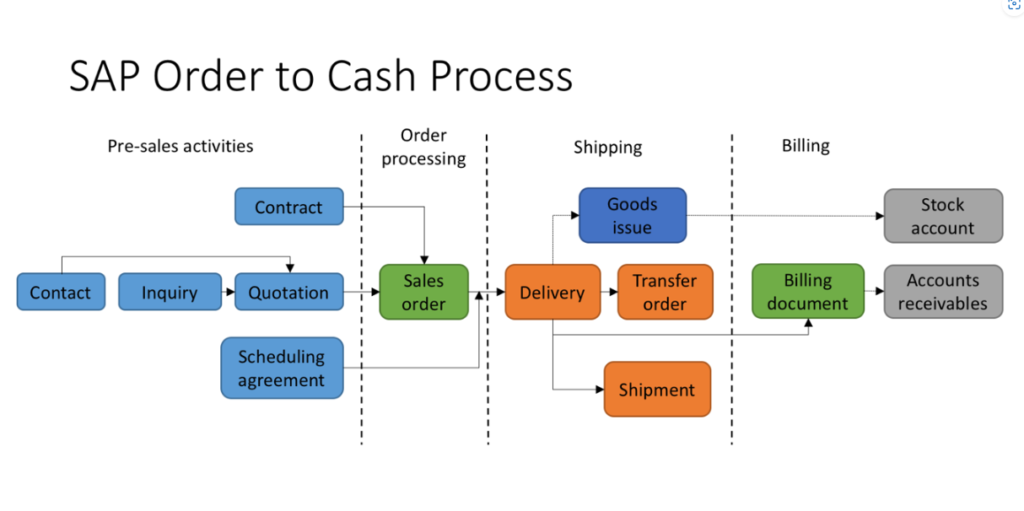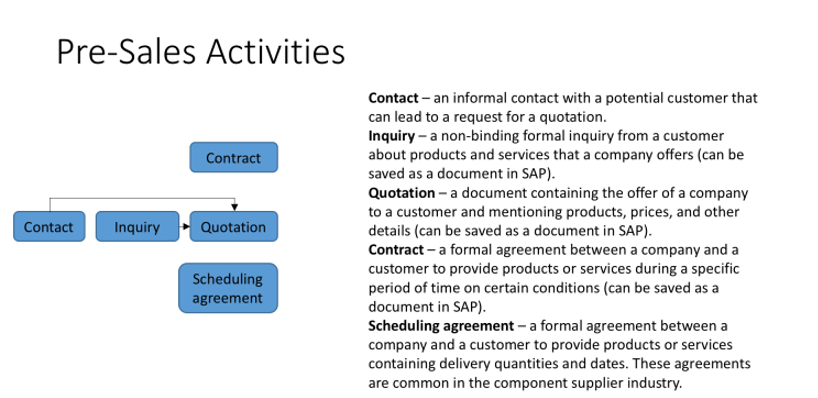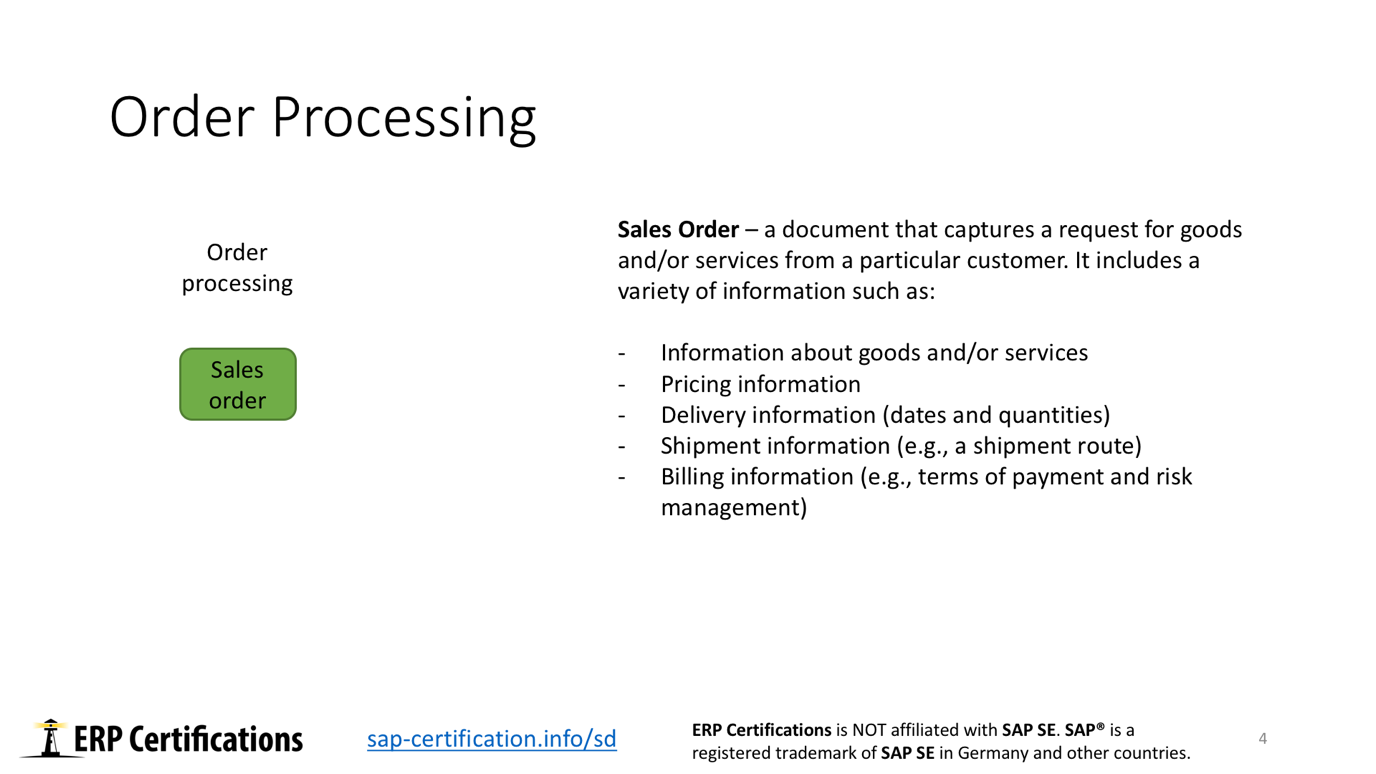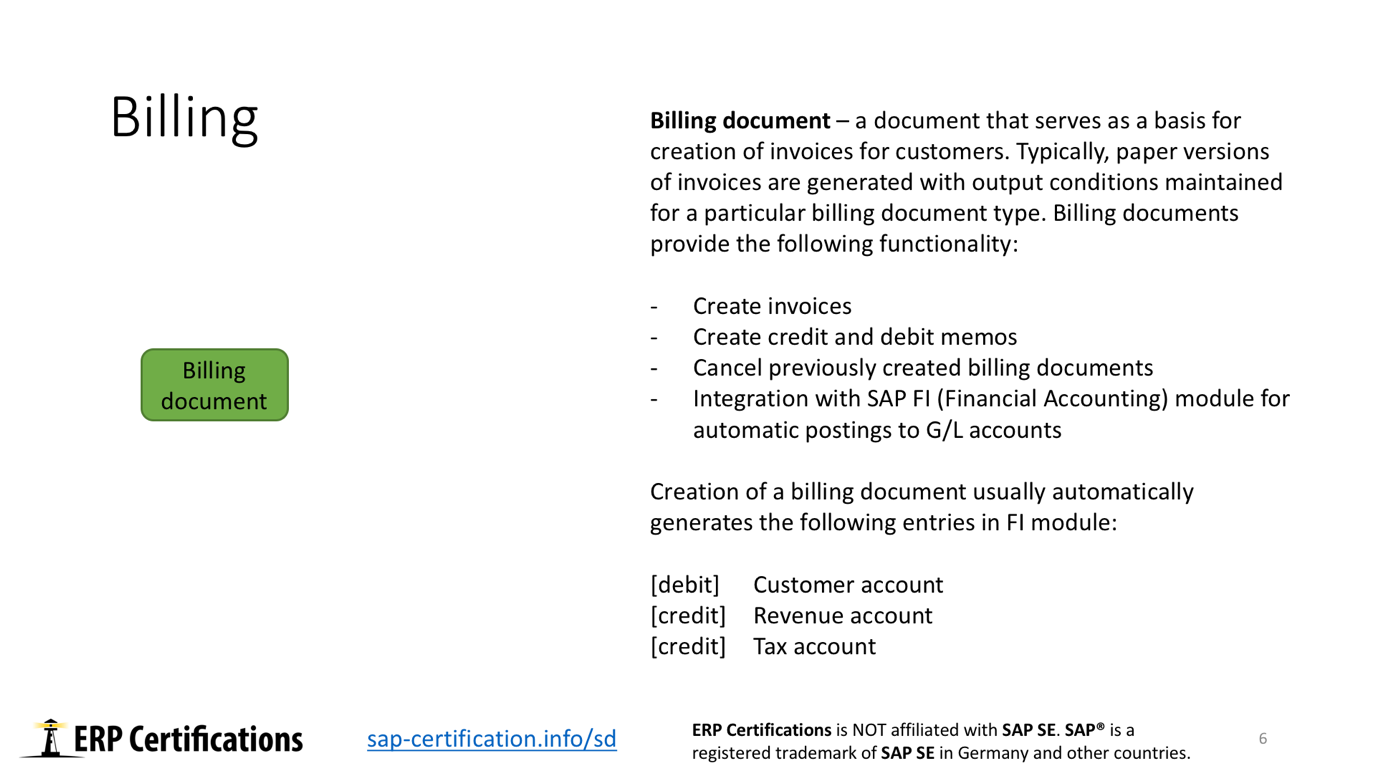Welcome to the introductory lesson on the SAP Order to Cash Process. This lesson serves as a component of the premium SAP SD training course and is also featured in the free SAP SD course as a sample of the premium content. In this initial module, we will delve into the business processes within SAP SD, beginning with a comprehensive overview of the Order to Cash process—a fundamental sales business process adopted by numerous companies in various forms.
SAP Order to Cash Process Overview
This slide presents a graphical overview of the SAP Order to Cash business process within the SAP ERP system. Each box represents a specific document or action. The process is divided into four primary stages: pre-sales activities, order processing, shipping, and billing. Pre-sales activities are conducted prior to the finalization of a sales transaction.

The order processing stage encompasses activities that capture and formalize customer requests, along with pricing and delivery terms. Following this stage, the customer commits to purchasing goods or services, and the company may fulfill the order from existing stock, procure new goods from suppliers, or manufacture the items as per the customer’s specifications.
Once the goods are prepared for dispatch, the shipping phase of the SAP order-to-cash process commences. This phase includes the creation of an outbound delivery document, the packaging and preparation of goods, transport planning, and the eventual shipment from the warehouse.
In addition to dispatching goods, generating an invoice is crucial so the customer is informed of the payment due to the company. In SAP, customer invoices are generated from billing documents. Therefore, the billing phase of the SAP order-to-cash process is concerned with the creation of these billing documents.
Let’s now examine each step of the SAP order-to-cash process in further detail.
Pre-sales Activities in SAP Order to Cash Process
The pre-sales activities in the SAP order-to-cash process encompass various steps and associated documents. It is important to note that these steps are not compulsory, and it is possible to bypass the pre-sales activities entirely and proceed directly to creating an SAP sales order. Nonetheless, these steps are commonly utilized by businesses, which is why SAP provides functionalities to facilitate them.

A contact is an informal interaction with a potential customer that may lead to a request for a quotation.
An inquiry is a formal, non-binding request from a customer for information about a company’s products and services, which can be documented in SAP.
A quotation is a document that outlines a company’s offer to a customer, detailing products, prices, and other specifics, and can be recorded in SAP.
A contract is a formal agreement between a company and a customer to supply products or services over a specified time frame under agreed-upon terms, and can be documented in SAP.
A scheduling agreement is a formal contract between a company and a customer for the supply of products or services, specifying delivery quantities and dates, commonly used in the component supplier industry.
SAP provides a useful feature that allows the transfer of data from pre-sales documents into sales orders, thereby avoiding repetitive data entry in the SAP ERP system and streamlining a company’s sales operations.
Order Processing Activities in SAP Order to Cash Process
Next, let’s have a look at the order processing state of SAP order to cash process. On this stage, the main focus is on SAP sales order document.

Sales Order – a document that captures a request for goods and/or services from a particular customer. It includes a variety of information such as:
- Information about goods and/or services
- Pricing information
- Delivery information (dates and quantities)
- Shipment information (e.g., a shipment route)
- Billing information (e.g., terms of payment and risk management)
Shipping Activities in SAP Order to Cash Process
When SAP sales order has been finalized and confirmed, it is time to move to the next stage of SAP order to cash process that is related to shipping goods or delivering services to the customer. The main document on this stage is called SAP outbound delivery and it helps to perform various activities related to shipment.

Outbound delivery is a document that enables shipping of goods to a particular customer. It includes information about a number of activities:
- Picking and confirmation (Transfer orders)
- Packing
- Arranging transport and shipment (Shipment document)
- Posting goods issue (Material documents)
Please note that not all of these activities are mandatory. For example, some companies prefer not to capture packing process in SAP ERP but perform it outside of SAP. In these cases, they will not perform packing in outbound deliveries. SAP ERP is a highly customizable system that enables flexible configuration of weather a particular step of business process is optional or mandatory.
Posting goods issue process is integrated with SAP FI (Financial Accounting) module and generates automatic postings on G/L accounts:
[debit] Cost of Goods Sold (COGS) account
[credit] Inventory account
Billing Activities in SAP Order to Cash Process
Finally, the last stage of SAP order to cash process is related to billing the customer. The common practice is that the customer pays after receiving the goods but of course it is also possible to configure SAP to expect a step with an advance payment from the customer before any goods are dispatched.

Billing document is a document that serves as a basis for creation of invoices for customers. Typically, paper versions of invoices are generated with output conditions maintained for a particular billing document type. Billing documents provide the following functionality:
- Create invoices
- Create credit and debit memos
- Cancel previously created billing documents
- Integration with SAP FI (Financial Accounting) module for automatic postings to G/L accounts
Creation of a billing document usually automatically generates the following entries in FI module:
[debit] Customer account
[credit] Revenue account
[credit] Tax account
After creating of a billing document a company we will wait for a payment from the customer. However, the payment transaction is considered to be part of SAP FI (Financial Accounting) module. Therefore, knowledge of how payment is performed and captured in SAP ERP is not required from an SAP SD consultant. However, for your overall development it is useful to know that a payment from the customer will generate a debit posting on the cash account and a credit posting on the customer account.